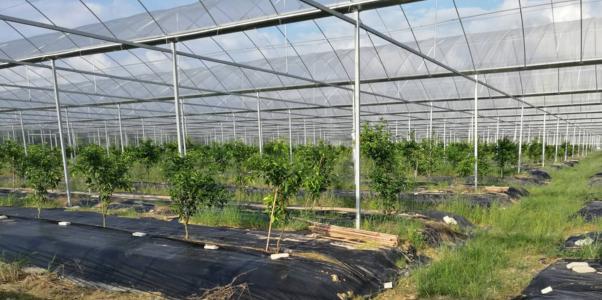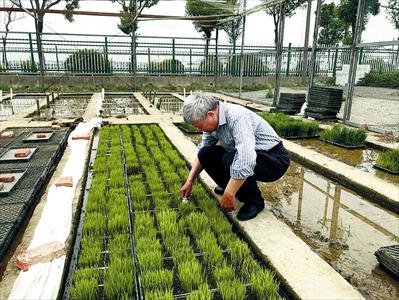Net room greenhouse: the prevention and control of diseases and insect pests, what is the control method of diseases and insect pests?
Do you know the biological control of crop pests cultivated in the net room? What are the reasons for the occurrence of pests in the net room? What are the reasons for the difficulties in pest control in net rooms? What are the advantages of net room biological control? Let's take a look at it. Get to know it. Understanding from past experience that biological control can effectively control greenhouse whitefly, this successful example has been recognized, prompting scholars to make efforts in the direction of biological control. However, facility horticulture covers a wide range of aspects, including horticultural breeding, cultivation management and pest control. It is suggested that according to the types of cultivated crops, form a research group and give full play to team spirit in order to solve the current problem of protected horticultural pests.

Causes of insect pests in net rooms
The net room is surrounded by fine nets, which can prevent the invasion of large insects, but due to the entry and exit of personnel and the transportation of potted seedlings, small insects can take advantage of gaps to invade, or be brought into the net room through seedlings. Accidental invading insects can multiply in large numbers if they are not extinguished in time. Especially after crop harvest, if the net room is not thoroughly disinfected, some pests pupate in the soil or hide in the cracks of facilities and buildings, or even overwinter on weeds. The indoor temperature of the net is lower than that outside, the difference of high temperature is small, and the growth of pests is faster. There is no strong wind and rain in the net room, which will not interfere with the male and female mating behavior of insect pests, so the reproduction rate increases greatly. In a mild climate, a single crop can provide the growth and development of several pests at the same time, reproducing several generations quickly in a short period of time.
Species and harmful habits of insect pests in net rooms
Common pests in net rooms are aphids, whiteflies and mites, which often gather on the back of crop leaves or hide near young heart leaves. The larvae of leaf miners sneak into the mesophyll to feed; the yellow-striped leaf flea larvae feed on the roots of cruciferous vegetables; thrips endanger young leaves, buds and young fruits, and some visit thrips, which feed on pollen grains in flowers, causing flowers to wither in the early stage, or crops bloom without fruiting.
Causes of difficulties in Pest Control in net Room
Once pests occur in net-room cultivated crops, even if pesticides are applied, it is difficult to completely control them after one spraying, because the pests are small and hidden on the back of the leaves, and it is difficult to get in touch with the pests after spraying pesticides on the leaves. For example, red spiders, which can be spun between leaf veins, are hidden under the line, which is also the reason for the control effect on mites.

Rational cultivation and management of net-room crops can reduce the occurrence of insect pests.
The culture soil or medium of crops cultivated in net room can be disinfected before planting, which can reduce the occurrence of underground pests; if the content of soil organic matter is too high, the adults of beetles may be attracted to lay eggs, resulting in beetle larvae harming the roots of crops. Hanging yellow sticky paper in the net room can effectively control whitefly and aphids.
Transportation of production, storage and storage of natural enemies
1. Mass production of natural enemies: at present, about 15 manufacturers produce natural enemies in large quantities to supply greenhouse biological control. The species that produce a large number of natural enemies are aphid wasps, plant mites and parasitic wasps of leaf miner. Manufacturers often produce natural enemies by breeding parasitic insects in large numbers on host plants, and then using parasitic insects to reproduce natural enemies. Although the natural enemies were raised in artificial medium, there are still some difficulties to be broken through.
two。 Storage and transportation of natural enemies: most natural enemies use pupa for short-term low temperature storage, and the storage temperature is about 4 ~ 15 degrees. In the experiment of liquid cryopreservation. Natural enemies are transported to the buyer by mail within 48 hours after production. During the transportation process, attention should be paid to the maintenance of humidity and the provision of food. Food includes honey and catch-up insects. If the transport conditions are poor, it will lead to the death of natural enemies, so the package and the mode of delivery are very important.
The way of release of natural enemies
The natural enemies lay eggs and parasitize on the host egg slices. When the eggs develop to the pupal stage, the eggs are placed in the net before Eclosion, which is the release mode of the general parasitoids. The whole batch of plant mites were placed in the net room together with the host plants. The parasitic wasps of leaf miners release adults and place their natural enemies directly on the plant with their bare hands. When releasing the natural enemies of whitefly and leaf miner, we should know exactly the parasitic age of the host insect in order to obtain effective results.
Advantages of biological control in net room
1.
Spraying insecticides in the young stage or flowering and pollination stage will cause drug damage, and it is ideal to release natural enemies to control pests at this time.
two。
Releasing natural enemies in the net room at once can last for a long period of time. For example, insect agents must be sprayed at intervals, and during the crop harvest period, it is impossible to spray at all, and during the crop harvest period, it is best to release the natural enemies.
3.
Whitefly, red spider and leaf miner, which are common in the net room, have strong resistance to insecticides, and it is difficult to apply pesticides to control them.
4.
Crops cultivated in the net, such as tomatoes, eggplants and cucumbers, are harvested every 2-3 days during the harvest period. If the application of pesticides will cause pesticide residues in the fruit, there is no such concern about releasing natural enemies at this time.
5.
The application of pesticides must be sprayed every three weeks, and biological control can be continued once, so it is cheaper to implement biological control from the evaluation of cultivation cost.
Successful examples of biological control in net room greenhouse at home and abroad
Using traditional insecticides to control pests in net room or greenhouse has been unable to meet the actual needs, while biological control is considered to be a feasible and important control method. At present, there are successful examples in Europe, such as the United Kingdom and the Netherlands, and there have been commercial breeding of natural enemies for biological control.
(1) as early as 1926, tomatoes, cucumbers and sweet peppers were grown in greenhouses in the United Kingdom, and greenhouse whitefly Trialeurodes vaporario rum (Westood) occurred and was biocontrolled by a parasitic wasp (Encarsia formosa). At present, a large number of parasitic wasps are released in the Netherlands to control flower whitefly.
(2) when red spiders (Tetranychus urticae) occur when tomatoes, cucumbers, sweet peppers and chrysanthemums are planted in the greenhouse, a large number of plant mites (P (Phytoseiulus persimilis) are released to control them.
(3) when peach aphid (Myzus persicae) occurs when planting sweet pepper and chrysanthemum in greenhouse, aphid wasp (Aphidius matricariae) is released to control. The area of greenhouse where natural enemies are used to control pests has reached 1000 hectares in the Netherlands and about 300ha in the United Kingdom. Other countries such as Denmark, Sweden, Finland and Ireland have commercial mass production of natural enemies for biological control.
(4) papaya was cultivated in the net room of the province to avoid the spread of papaya rotation disease by aphids, red spiders were easy to occur in the contents of the net room, and a large number of lacewings were released to control red spiders in the papaya garden, and good results were obtained.
Selective insecticides such as insect growth regulators (Insect growth regulator) and microbial insecticides, such as Bacillusthur ingiensis, must be taken into the digestive tract through the chewing mouthparts of insects in order to kill pests.
Belong to piercing and aspirating mouthparts, these two kinds of selective insecticides do not harm natural enemies.
- Prev

How to control perennial malignant weeds: weed control methods of how to control malignant weeds
Weed control, how to grow crops, there will be the existence of weed problems, then how to control weeds? You know what? if you don't know, let's get to know it. Interference of weeds on the normal growth of crops, and pests such as pathogens and insects (p
- Next

The importance of biological control of plant diseases and the biological control methods of plant diseases
The application and prospect of biological control of crop diseases, is that what you do? Want to know? What are the application and development directions of biological control in plant diseases? So how do you do it? what's the method? Let's take a look at it. Biology
Related
- A one-day flower show brings 130 million yuan in orders! Nanhai, this Phalaenopsis exhibition is amazing
- What do the flower language and meaning of Lutheran tree mean? Precautions for planting Lutheran tree
- Encounter Chaoshan Kongfu tea, not without this cup of Phoenix single clump
- The durian market in Vietnam and Thailand is flooded. The price of imported durian has plummeted by 30-40% in a month.
- Shanghai solved the problem of local vegetable supply by planting 80,000 mu of green leafy vegetables.
- Wageningen University has become the best agricultural university in the world for the seventh time in a row.
- The strongest export season of South African grapes is full of challenges, with exports to Russia falling sharply by 21%.
- Sri Lanka is on the verge of bankruptcy, "Tea for debt" Organic Agriculture Revolution aggravates the Food crisis?
- Turning waste into earthworm manure and worm manure into organic fertilizer-A new choice for auxiliary farming
- Organic rice growers shoulder the responsibility of nurturing agricultural talents! Yinchuan Sustainable Farm with Organic Life Camp

